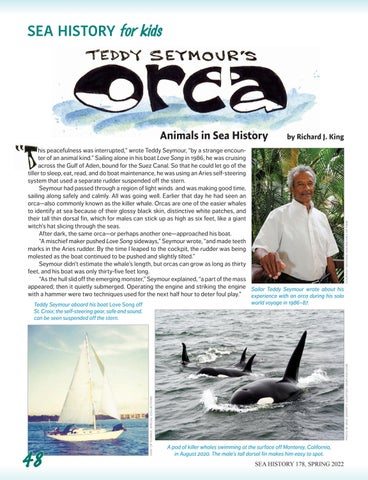SEA HISTORY for kids
by Richard J. King
his peacefulness was interrupted,” wrote Teddy Seymour, “by a strange encounter of an animal kind.” Sailing alone in his boat Love Song in 1986, he was cruising across the Gulf of Aden, bound for the Suez Canal. So that he could let go of the tiller to sleep, eat, read, and do boat maintenance, he was using an Aries self-steering system that used a separate rudder suspended off the stern. Seymour had passed through a region of light winds and was making good time, sailing along safely and calmly. All was going well. Earlier that day he had seen an orca—also commonly known as the killer whale. Orcas are one of the easier whales to identify at sea because of their glossy black skin, distinctive white patches, and their tall thin dorsal fin, which for males can stick up as high as six feet, like a giant witch’s hat slicing through the seas. After dark, the same orca—or perhaps another one—approached his boat. “A mischief maker pushed Love Song sideways,” Seymour wrote, “and made teeth marks in the Aries rudder. By the time I leaped to the cockpit, the rudder was being molested as the boat continued to be pushed and slightly tilted.” Seymour didn’t estimate the whale’s length, but orcas can grow as long as thirty feet, and his boat was only thirty-five feet long. “As the hull slid off the emerging monster,” Seymour explained, “a part of the mass appeared; then it quietly submerged. Operating the engine and striking the engine Sailor Teddy Seymour wrote about his with a hammer were two techniques used for the next half hour to deter foul play.” experience with an orca during his solo
univ. of florida , special collections
photo by mike doherty, courtesy unsplash.com
world voyage in 1986–87.
Teddy Seymour aboard his boat Love Song off St. Croix; the self-steering gear, safe and sound, can be seen suspended off the stern.
48
courtesy national sailing hall of fame
Animals in Sea History
A pod of killer whales swimming at the surface off Monterey, California, in August 2020. The male’s tall dorsal fin makes him easy to spot.
SEA HISTORY 178, SPRING 2022
